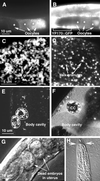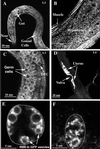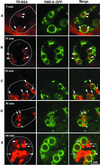RME-8, a conserved J-domain protein, is required for endocytosis in Caenorhabditis elegans
- PMID: 11451999
- PMCID: PMC55649
- DOI: 10.1091/mbc.12.7.2011
RME-8, a conserved J-domain protein, is required for endocytosis in Caenorhabditis elegans
Abstract
By genetic analysis of Caenorhabditis elegans mutants defective in yolk uptake, we have identified new molecules functioning in the endocytosis pathway. Here we describe a novel J-domain-containing protein, RME-8, identified by such genetic analysis. RME-8 is required for receptor-mediated endocytosis and fluid-phase endocytosis in various cell types and is essential for C. elegans development and viability. In the macrophage-like coelomocytes, RME-8 localizes to the limiting membrane of large endosomes. Endocytosis markers taken up by the coelomocytes rapidly accumulate in these large RME-8-positive endosomes, concentrate in internal subendosomal structures, and later appear in RME-8-negative lysosomes. rme-8 mutant coelomocytes fail to accumulate visible quantities of endocytosis markers. These observations show that RME-8 functions in endosomal trafficking before the lysosome. RME-8 homologues are found in multicellular organisms from plants to humans but not in the yeast Saccharomyces cerevisiae. These sequence homologies suggest that RME-8 fulfills a conserved function in multicellular organisms.
Figures







References
-
- Adams MD, et al. The genome sequence of Drosophila melanogaster. Science. 2000;287:2185–2195. - PubMed
-
- Bettinger JC, Lee K, Rougvie AE. Stage-specific accumulation of the terminal differentiation factor LIN-29 during Caenorhabditis elegans development. Development. 1996;122:2517–2527. - PubMed
-
- Christoforidis S, McBride HM, Burgoyne RD, Zerial M. The Rab5 effector EEA1 is a core component of endosome docking. Nature. 1999;397:621–625. - PubMed
Publication types
MeSH terms
Substances
Associated data
- Actions
Grants and funding
LinkOut - more resources
Full Text Sources
Other Literature Sources
Molecular Biology Databases

